NCCAM Stakeholder Dialogue
June 20, 2007
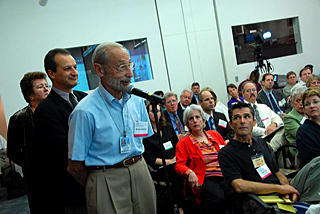
© Bob Stockfield
On Wednesday, June 20, 2007, the National Center for Complementary and Alternative Medicine (NCCAM) held a Stakeholder Dialogue on the National Institutes of Health (NIH) campus in Bethesda, Maryland.
More than 150 people participated in the day-long Dialogue, representing complementary and alternative medicine (CAM) schools, CAM and conventional professional associations; research, academic, and training institutions; patient organizations; and industry groups. Members of the CAM community were particularly encouraged to attend.
The Center's Acting Director, Ruth Kirschstein, M.D., opened the Dialogue with a presentation about NCCAM's mission and activities. Participants were then invited to comment on NCCAM's activities and priorities, first in a general session moderated by Margaret Chesney, Ph.D., Deputy Director of NCCAM, followed by afternoon breakout sessions that addressed research, research training, and outreach that were led by NCCAM senior staff.
Throughout the day, participants were invited to comment on three key questions:
- What are the greatest opportunities for research in the next few years?
- What are the greatest challenges to conducting CAM research?
- What impact will CAM research have on trends in integrative medicine?
This summary outlines some of the themes that emerged during the Dialogue.
Research Opportunities
- Develop a research model focused on health promotion and disease prevention.
- CAM practices often focus on health promotion, so NCCAM should fund more research on health promotion, disease prevention, and wellness.
- Use the full array of existing research methodologies to study CAM - for example, observational, descriptive, longitudinal, preference, comparison, ground, best-case, qualitative, and cluster studies.
- Develop new research methodologies to study whole medical systems and CAM approaches that combine multiple modalities and CAM domains (i.e., complex, combination treatments).
- Such methodologies would enable researchers to study CAM modalities as they are typically used in practice.
- New technologies, such as advanced imaging techniques for measuring outcomes, could be used.
- Leverage practice- and community-based CAM resources.
- Conducting CAM clinical trials and other research in the community rather than in academic/research settings would mirror the environment in which CAM is typically used.
- There may be opportunities to conduct research with Native Americans in their communities to study traditional healing practices.
- Continue to foster collaboration among conventional and CAM communities.
- NCCAM provides a venue for collaboration between the CAM and conventional communities that is fundamental for meaningful CAM research. CAM practitioners need to be trained in research, and conventional researchers need to involve CAM practitioners in their research.
- Research initiatives with multiple principal investigators help foster collaborations.
- Research Training
- Continue to support research training and career development in CAM schools and institutions, and encourage CAM research training in conventional medical schools and universities.
- Provide opportunities in research training for CAM practitioners who may not be eligible or competitive for current NCCAM/NIH funding opportunities.
- Provide support at every stage of independent research careers, through competitive fellowships and career development awards for both conventionally trained and CAM practitioner applicants.
- Consider combining CAM research with genetics research in the context of personalized medicine.
- Advances in genetics research allow tailoring of interventions. Because CAM practices are often individualized, there may be opportunities to combine genetics and CAM research.
- Study the placebo effect.
- Opportunities exist to harness the potential clinical benefits of the placebo effect.
- Patient-provider interactions are often an important component of CAM practices as well as of the placebo effect.
- Study pediatric CAM use.
- There is a need to study CAM use for children. Children do not react to therapies the same way as adults, yet parents often seek CAM for conditions that do not respond to conventional treatments.
- Communication about Research
- Continue to share research results with all stakeholders through the NCCAM web site and by using other web-based tools.
- Strengthen ties between NCCAM and the CAM practitioner and patient advocacy communities.
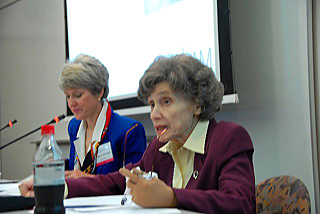
© Bob Stockfield
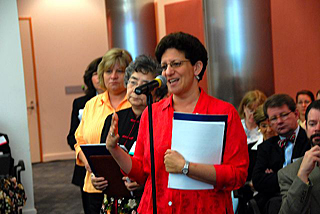
© Bob Stockfield
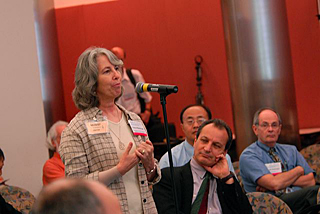
© Bob Stockfield
2. Research Challenges
Participants identified the following challenges to conducting CAM research:
The treatment-focused research model is not designed to study whole medical systems or health promotion/disease prevention.
- Outcome measurements and appropriate trial design are needed for multi-pronged approaches to health and for the study of health promotion.
- Mechanisms of action are unknown for most CAM modalities and more research is needed on mechanisms of action.
- Outcomes for CAM modalities may be atypical. Need to fund development for outcome measures.
- Difficulty standardizing botanical materials.
- Lack of participation of CAM practitioners in CAM research.
- Most CAM schools lack a research infrastructure. In addition, it is difficult for CAM practitioners to find opportunities to work with researchers to develop protocols.
- More information about applying for grants and feedback on grant applications are needed.
- While CAM practitioners are often included in the review process, those involved need to have expertise in the specific CAM modality being proposed for study.
- The broad scope of CAM research requires strategic investment of the Center's research dollars.
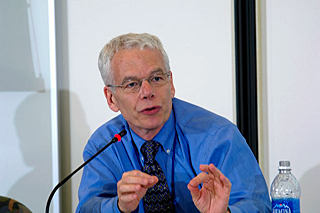
© Bob Stockfield
3. Research's Impact on Integrative Medicine Trends
Participants noted that interest in CAM among the public, as well as among conventional medical providers and researchers, is setting the stage for integrative medicine. They noted, however, that barriers must be addressed in order for CAM research to have a substantial impact on trends in integrative medicine. For example:
- Regulatory barriers and scope-of-practice issues.
- The effects of such barriers can be wide-ranging, extending even to challenges in using inclusive language to describe CAM practitioners. For example, though many CAM practitioners cannot legally claim to practice medicine, the word "medicine" is part of the acronym "CAM."
- Lack of insurance coverage of CAM and lack of cost-effectiveness studies.
- CAM practices that are not covered by insurance are not likely to be fully integrated with standard care.
- Cost-effectiveness studies on CAM are scarce.
- Lack of accessible CAM research results on safety and efficacy.
- CAM research results are not typically integrated in conventional medical school curricula.
- Conventional and CAM practitioners and the public do not know where to find reliable and easy-to-understand information about CAM research results.
Organizations Represented at the Dialogue
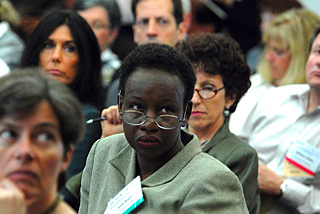
© Bob Stockfield
A. T. Still University
Academy of Oriental Medicine at Austin
Alliance for Integrative Health Care
Alternative Medicine Foundation, Inc.
American Academy of Orthopaedic Surgeons
American Association of Acupuncture and Oriental Medicine
American Association of Colleges of Osteopathic Medicine
American Board of Holistic Medicine
American Herbal Products Association
American Holistic Nurses Association
American Library for Health
American Massage Therapy Association
American Organization for Bodywork Therapies of Asia
American Osteopathic Association
American Physical Therapy Association
Annie Appleseed Project
Association of Chiropractic Colleges
Athinoula A. Martinos Center for Biomedical Imaging,
Massachusetts General Hospital/Massachusetts Institute of Technology/Harvard Medical School
Atlantic Institute of Oriental Medicine
Bastyr University
Beth Israel Deaconess Medical Center, Harvard Medical School
Bryn Mawr College
Capitol Hill Consulting Group
Center for Cancer Care, Goshen, Indiana
Cleveland Chiropractic College
Coalition for Natural Health, Inc.
Columbia University School of Nursing
Council for Responsible Nutrition
Dragon Rises College of Oriental Medicine
East West Academy of Healing Arts
Exponent, Inc.
George Washington University Medical Center
Grace Wellness
Health Freedom Foundation
Helfgott Research Institute at the National College of Natural Medicine
Hesser College
Indian Health Service, U.S. Department of Health and Human Services
Institute of Clinical Acupuncture and Oriental Medicine
Integrated Healthcare Policy Consortium
International Association of Structural Integrators
International Society for the Study of Subtle Energies and Energy Medicine
International Somatic Movement Education and Therapy Association
Johns Hopkins School of Medicine
Kennedy Krieger Institute
Life Chiropractic College West
Life University
Logan College of Chiropractic
Lutheran Medical Center, Brooklyn, New York
Mannatech, Inc.
Massage Therapy Foundation
Montgomery County [Maryland] Council
National Center for Homeopathy
National College of Natural Medicine
National University of Health Sciences
Natural Products Association
National Cancer Institute
National Eye Institute
National Institute of Allergy and Infectious Diseases
National Institutes of Health, Office of Extramural Research
New England School of Acupuncture
New York Chiropractic College
New York College of Traditional Chinese Medicine
New York University
Oregon College of Oriental Medicine
Phyto-Technologies, Inc.
PinnacleCare
Potomac Massage Training Institute
Psychosocial Assistance Without Borders
Reinecke Strategic Solutions
Rolf Institute
Rush University Medical Center, College of Nursing
SENSE Incorporated
Smith-Kettlewell Eye Research Institute
Southern California University of Health Sciences
Tai Sophia Institute
Texas Association of Acupuncture and Oriental Medicine
Touro College School of Health Sciences, Oriental Medicine Program
Trager International
U.S. Department of Veterans Affairs
U.S. Pharmacopeia
Uniformed Services University of the Health Sciences
United Holistic Practitioners Association, LLC
University of Arizona, Department of Family and Community Medicine
University of Arizona, Program in Integrative Medicine
University of California, Irvine, Susan Samueli Center for Integrative
Medicine
University of California, San Francisco, Osher Center for Integrative Medicine
University of Hawaii, John A. Burns School of Medicine
University of Kentucky
University of Medicine and Dentistry of New Jersey,
Institute for Complementary and Alternative Medicine
University of Michigan Integrative Medicine
University of North Carolina School of Medicine at Chapel Hill,
Program on Integrative Medicine
University of North Texas
University of Pennsylvania School of Medicine
University of Texas Medical Branch
University of Vermont
University of Washington
Utah Natural Products Alliance
Wake Forest University School of Medicine
Wisneski Health Associates
Wisneski Institute
Yale-Griffin Prevention Research Center
